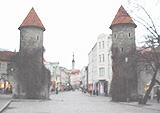|
Front
Line
|

Medieval walls around the historic city of Tallinn, the capital of Estonia
By brother initiate Jacky Chantraine, Brussels, Belgium (Originally in English)
Estonia is a small republic of only 1,500,000 inhabitants near the Baltic Sea that has been independent since 1991. The Estonian language is similar to Finnish and Hungarian and is part of the original language spoken by people in the area of the Ural Mountains in Russia. The official name of Estonia is "Eeti".
Knowing a few weeks in advance that I had lectures to give to Finnish students in Helsinki, I decided to go one day to Estonia to distribute some of Master's sample booklets, as I know that Master has not yet traveled to that country. It was impossible for me to carry many sample booklets to Estonia, because I also had to carry a large amount of educational material with me. But I had to decide which language was the best. Sample booklets in Estonian do not yet exist, and Russian sample booklets were not available to me. After looking at the web information on Estonia, I discovered that 26% of the country's active population has a university education and that English is widely understood by the younger generation, so I took sample booklets in English.
The distance between Helsinki and Tallin (the capital of Estonia) is only 80 kilometers; both cities are only separated by the Gulf of Finland. When the weather is good, it takes only one hour and 40 minutes to cross the sea by express boat; but when the sea is iced over, large boats have to break the ice, and the trip takes more than three or four hours. Happily for me, on that late November day, the weather conditions were good.
When I arrived in Tallinn, the weather was cold and the water on the streets had turned to ice. The old town of Tallinn (Vanallinn) appears as a jewel: The city is still as it was in the Middle Ages, and medieval walls still surround it. But I asked myself where I should distribute the nine sample booklets that I had brought with me, which I called "the nine drops of love." No one in Estonia had heard of Supreme Master Ching Hai and the Quan Yin Method, and I did not want to hand out my booklets randomly, without knowing if people would be interested in reading them.
Then I let myself be guided by the "karmic wind." I walked here and there in the medieval city, and an inner voice told me several times: "Not here; it's not a good place" or "Wait a little while longer."
During my walk in the historic city, I noticed two little bookstores, and entered the first one. The Estonians there were not used to receiving free books, and so the salesman asked the manager to come over to speak with me; after a short discussion, he agreed to take the sample booklets to give to his clients.
Then I entered the second shop, located on Voorimehe Street, and asked the manager to accept the remaining sample books. He was as surprised as the other manager, but finally agreed to show Master's booklets in the small corner of his shop where religious books were displayed.
Only nine drops of love were distributed in Estonia, but I am sure that the number is not significant. The ocean of love is made of millions of drops, and each is important; only the beginning of the process is of importance.
It is the same in agriculture. Nine seeds can lead to thousands of flowering trees if the karmic wind blows in a good direction. Who will read these sample booklets? Who will perhaps change his life after reading one of them? Perhaps one of the readers will be the first Estonian contact person in the future.
During my way back to the harbor where the boat was waiting for me, the same words came back to my mind: "Nine drops of love ... nine drops of love ... "
|
E-news
Subscribe Magazine Online
Subscribers will receive the latest e-magazine, as well as selected aphorisms, "Pearls of Wisdom", etc. |
|
News
No. 118
Contents |
